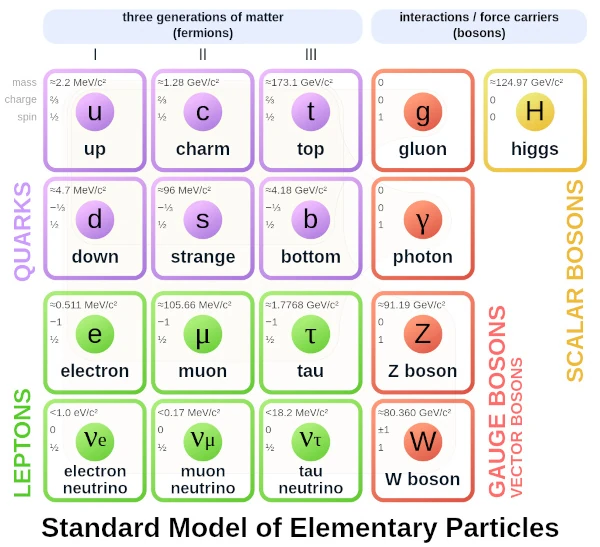
The electroweak force refers to the theoretical unification of two of the four fundamental interactions: the electromagnetic interaction (mediated by the photon) and the weak interaction (mediated by the W⁺, W⁻, and Z⁰ bosons). This unification, proposed by physicists Sheldon Lee Glashow (1932-), Abdus Salam (1926-1996), and Steven Weinberg (1933-2021) between 1967 and 1979, is one of the pillars of the Standard Model of particle physics. At high energies (above ~100 GeV), the weak interaction and electromagnetism are no longer distinguishable: they arise from the same symmetry framework, based on the gauge fields \( \mathrm{SU}(2)_L \times \mathrm{U}(1)_Y \), unified before symmetry breaking by the Higgs field. After symmetry breaking by the Higgs field, they separate into two distinct forces.
The weak interaction is one of the four fundamental interactions of nature, characterized by its ability to change the very nature of particles, particularly within atomic nuclei. It manifests through phenomena such as beta decay and neutrino scattering and is distinguished by its extremely short range and massive mediators.
The weak interaction acts on fermions—leptons and quarks—by changing their flavors (types), which is not possible with any other fundamental force. This interaction is mediated by three massive vector bosons: W+, W-, and Z0. The high mass of these bosons (approximately 80.4 to 91.2 GeV/c²) severely restricts the range of the interaction to about 10-18 meters, a thousand times smaller than the size of a proton.
Weak interactions cause so-called "charged" (via W±) and "neutral" (via Z0) processes:
Formally, the weak interaction is part of the non-Abelian gauge theory associated with the group SU(2)L, which implies that only left-handed fermions (left chirality) are affected. This property introduces a fundamental violation of spatial inversion symmetry (parity), observed experimentally in the 1950s.
Beyond microscopic processes, the weak interaction plays a crucial role in stellar physics, particularly in the fusion reactions that power the Sun, and in the synthesis of heavy elements through radioactive decay. It is also involved in the matter-antimatter asymmetry and the thermal evolution of the early Universe.
The framework of electroweak unification is based on the gauge symmetry \( SU(2)_L \times U(1)_Y \). This gauge group predicts four mediator bosons: \( W^1, W^2, W^3 \) (from SU(2)) and \( B^0 \) (from U(1)). After spontaneous symmetry breaking via the Higgs mechanism, these bosons recombine to give:
This process is governed by a fundamental angle: the Weinberg angle \( \theta_W \), which explains why the photon is massless and responsible for electromagnetism, and the Z boson is massive and neutral, related to the weak interaction.
In the primordial universe, where the temperature exceeded \( 10^{15} \,\text{K} \), the electromagnetic interaction and the weak interaction were unified. As the universe cooled, a phase transition occurred, causing the spontaneous breaking of electroweak symmetry. The Higgs field, by interacting with the vector bosons, gave them mass. The photon, on the other hand, remains massless because it does not interact with the Higgs field.
The electroweak force constitutes a fundamental link unifying two seemingly distinct phenomena: light, carried by the photon of electromagnetism, and radioactivity, a manifestation of the weak interaction. This unification is based on a common mathematical framework \( SU(2)_L \times U(1)_Y \) where, at high energy, the differences between the interactions fade and emerge from the same gauge field.
This "bridge" reveals that visible light and radioactive decay processes share a common origin in quantum field physics, differentiated only by the spontaneous symmetry breaking induced by the Higgs field. Consequently, the electroweak force embodies the elegance and coherence of the Standard Model, while paving the way for more unified theories seeking to describe all fundamental forces.